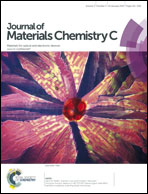Eu2+/Eu3+-emission-ratio-tunable CaZr(PO4)2:Eu phosphors synthesized in air atmosphere for potential white light-emitting deep UV LEDs
Abstract
Mixed-valence Eu-doped CaZr(PO4)2 was prepared in air atmosphere by a two-step solid-state reaction for the first time. The reduction of Eu3+ to Eu2+ in air atmosphere was observed in the second synthesis step via the use of NH4H2PO4 and the first-step product CaZrO3:Eu3+ to synthesize CaZr(PO4)2:Eu, which strengthens the evidence linking the tetrahedral anion groups PO4 with the Eu reduction. This reduction mechanism is explained by a charge compensation model. The luminescence measurements indicate that the obtained phosphors exhibit a broad bluish-green fluorescence of Eu2+ and a sharp orange-red emission of Eu3+ on 200–350 nm ultraviolet (UV) excitations. A tunable white luminescence covering the whole visible spectrum is realized based on the gradual reduction of Eu3+ to Eu2+ with increasing the sintering time. The optimal white luminescence excited at 247 nm presents the CIE color coordinates of (0.322, 0.305), a correlated color temperature of 6243 K, and a good thermal stability. Furthermore, energy transfer from Eu2+ to Eu3+ is found in CaZr(PO4)2:Eu. Our investigation of CaZr(PO4)2:Eu may provide a practical basis to design and fabricate novel phosphors for white light-emitting diodes (W-LEDs).


 Please wait while we load your content...
Please wait while we load your content...